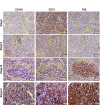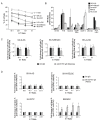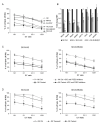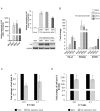Identification of neuroblastoma cell lines with uncommon TAZ+/mesenchymal stromal cell phenotype with strong suppressive activity on natural killer cells
- PMID: 33452207
- PMCID: PMC7813384
- DOI: 10.1136/jitc-2020-001313
Identification of neuroblastoma cell lines with uncommon TAZ+/mesenchymal stromal cell phenotype with strong suppressive activity on natural killer cells
Abstract
Background: Neuroblastoma (NB) is the most common, extracranial childhood solid tumor arising from neural crest progenitor cells and is a primary cause of death in pediatric patients. In solid tumors, stromal elements recruited or generated by the cancer cells favor the development of an immune-suppressive microenvironment. Herein, we investigated in NB cell lines and in NB biopsies, the presence of cancer cells with mesenchymal phenotype and determined the immune-suppressive properties of these tumor cells on natural killer (NK) cells.
Methods: We assessed the mesenchymal stromal cell (MSC)-like phenotype and function of five human NB cell lines and the presence of this particular subset of neuroblasts in NB biopsies using flow-cytometry, immunohistochemistry, RT-qPCR, cytotoxicity assays, western blot and silencing strategy. We corroborated our data consulting a public gene-expression dataset.
Results: Two NB cell lines, SK-N-AS and SK-N-BE(2)C, exhibited an unprecedented MSC phenotype (CD105+/CD90+/CD73+/CD29+/CD146+/GD2+/TAZ+). In these NB-MSCs, the ectoenzyme CD73 and the oncogenic/immune-regulatory transcriptional coactivator TAZ were peculiar markers. Their MSC-like nature was confirmed by their adipogenic and osteogenic differentiation potential. Immunohistochemical analysis confirmed the presence of neuroblasts with MSC phenotype (CD105+/CD73+/TAZ+). Moreover, a public gene-expression dataset revealed that, in stage IV NB, a higher expression of TAZ and CD105 strongly correlated with a poorer outcome.Among the NB-cell lines analyzed, only NB-MSCs exhibited multifactorial resistance to NK-mediated lysis, inhibition of activating NK receptors, signal adaptors and of NK-cell cytotoxicity through cell-cell contact mediated mechanisms. The latter property was controlled partially by TAZ, since its silencing in NB cells efficiently rescued NK-cell cytotoxic activity, while its overexpression induced opposite effects in non-NB-MSC cells.
Conclusions: We identified a novel NB immunoregulatory subset that: (i) displayed phenotypic and functional properties of MSC, (ii) mediated multifactorial resistance to NK-cell-induced killing and (iii) efficiently inhibited, in coculture, the cytotoxic activity of NK cells against target cells through a TAZ-dependent mechanism. These findings indicate that targeting novel cellular and molecular components may disrupt the immunomodulatory milieu of the NB microenvironment ameliorating the response to conventional treatments as well as to advanced immunotherapeutic approaches, including adoptive transfer of NK cells and chimeric antigen receptor T or NK cells.
Keywords: biomarkers; immune evation; killer cells; natural; neuroblastoma; tumor; tumor escape.
© Author(s) (or their employer(s)) 2021. Re-use permitted under CC BY-NC. No commercial re-use. See rights and permissions. Published by BMJ.
Conflict of interest statement
Competing interests: None declared.
Figures







Similar articles
-
Transition to a mesenchymal state in neuroblastoma may be characterized by a high expression of GD2 and by the acquisition of immune escape from NK cells.Front Immunol. 2024 Apr 26;15:1382931. doi: 10.3389/fimmu.2024.1382931. eCollection 2024. Front Immunol. 2024. PMID: 38736882 Free PMC article.
-
Microenvironment in neuroblastoma: isolation and characterization of tumor-derived mesenchymal stromal cells.BMC Cancer. 2018 Nov 27;18(1):1176. doi: 10.1186/s12885-018-5082-2. BMC Cancer. 2018. PMID: 30482160 Free PMC article.
-
GD2 redirected CAR T and activated NK-cell-mediated secretion of IFNγ overcomes MYCN-dependent IDO1 inhibition, contributing to neuroblastoma cell immune escape.J Immunother Cancer. 2021 Mar;9(3):e001502. doi: 10.1136/jitc-2020-001502. J Immunother Cancer. 2021. PMID: 33737337 Free PMC article.
-
Mesenchymal Stromal Cells in Neuroblastoma: Exploring Crosstalk and Therapeutic Implications.Stem Cells Dev. 2021 Jan 15;30(2):59-78. doi: 10.1089/scd.2020.0142. Stem Cells Dev. 2021. PMID: 33287630 Free PMC article. Review.
-
Natural killer cells in neuroblastoma: immunological insights and therapeutic perspectives.Cancer Metastasis Rev. 2024 Dec;43(4):1401-1417. doi: 10.1007/s10555-024-10212-8. Epub 2024 Sep 18. Cancer Metastasis Rev. 2024. PMID: 39294470 Free PMC article. Review.
Cited by
-
T cells in the microenvironment of solid pediatric tumors: the case of neuroblastoma.Front Immunol. 2025 Feb 28;16:1544137. doi: 10.3389/fimmu.2025.1544137. eCollection 2025. Front Immunol. 2025. PMID: 40092980 Free PMC article. Review.
-
Facilitation of Tumor Stroma-Targeted Therapy: Model Difficulty and Co-Culture Organoid Method.Pharmaceuticals (Basel). 2025 Jan 8;18(1):62. doi: 10.3390/ph18010062. Pharmaceuticals (Basel). 2025. PMID: 39861125 Free PMC article. Review.
-
IL-1R8 silencing improves the anti-tumor function of freshly isolated human NK cells.J Immunother Cancer. 2022 Mar;10(3):e003858. doi: 10.1136/jitc-2021-003858. J Immunother Cancer. 2022. PMID: 35292515 Free PMC article.
-
Gastric cancer mesenchymal stem cells inhibit natural killer cell function by up-regulating FBP1.Cent Eur J Immunol. 2021;46(4):427-437. doi: 10.5114/ceji.2021.111753. Epub 2021 Dec 23. Cent Eur J Immunol. 2021. PMID: 35125940 Free PMC article.
-
Tumor microenvironment-induced tumor cell plasticity: relationship with hypoxic stress and impact on tumor resistance.Front Oncol. 2023 Oct 11;13:1222575. doi: 10.3389/fonc.2023.1222575. eCollection 2023. Front Oncol. 2023. PMID: 37886168 Free PMC article. Review.
References
Publication types
MeSH terms
Substances
LinkOut - more resources
Full Text Sources
Other Literature Sources
Medical
Research Materials
Miscellaneous
